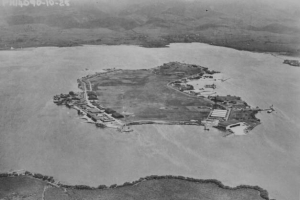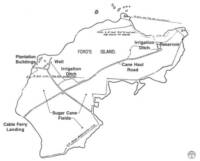Moku‘ume‘ume: The History of Ford Island
by William H. Dorrance (as published in Historic Hawai‘i Foundation News, December 1991)

This map of Moku‘ume‘ume (Ford Island) compiled from maps dated 1873–1915, shows that the island was primarily used for pasture.
Few people know the history of the island in Pearl Harbor named Moku‘ume‘ume. In fact, very few people know the island by that name because almost everyone calls it “Ford Island.” This is a story of that island.
Moku’ume‘ume is a small island located in Pearl Harbor on the Island of O‘ahu. It is entirely surrounded by water deep enough to accommodate deep-draft ocean-going vessels. The island measures about 1.4 miles long and 0.70 miles wide in a roughly elliptical shape. Its surface area is about 500 acres.
Moku‘ume‘ume means “island of ‘ume‘ume,” a game that the Hawaiians played. The game began with a gathering of commoners and chiefs around a bonfire on the island. As evening fell the leader chanted a lascivious song. Couples formed a ring about the leader and the fire. As he chanted, the leader used his swatch of a wand to touch a woman and then a man. The couple then retired to spend the night together.
While participants might have been married, they were not considered married during the game. In other words, ‘ume‘ume was a short-term mate swapping. At daylight the game was over and all players returned to their respective mates. The coming of the missionaries in the 1820s brought an end to this game. The influential Spaniard, Francisco de Paula Marin, took possession of the island around 1810. He raised sheep, hogs, goats, and rabbits on the island to supply his profitable ship-provisioning business.
Following a turbulent era of unsettled landownership during the early Hawaiian Kingdom, ownership of the island passed to a trust formed for the son of prominent Honolulu physician, Dr. Seth Porter Ford. Thus, the modern-day name for Moku‘ume‘ume was established. His son, Seth Porter Ford, Jr., took possession of the island about 1885.
“Ford Island” is roughly pronounced as “Poka ‘Ailana” in Hawaiian, and some native Hawaiians did refer to the island by that name. In 1891, Ford sold the island to the John Ii estate. This estate had vast landholdings in and around Pearl Harbor. Judge John Papa Ii (1800–1870) was a native Hawaiian of noble lineage who had served kings Kamehameha I, II, III, and IV.
Mr. Charles A. Brown married Judge Ii’s daughter and heir, Irene. He managed the estate from 1887 to 1916 after which his son, George Ii Brown, managed the estate.
The Ii Brown Family is well-known to dedicated golfers in Hawai’i. Francis Ii Brown, another son of Charles A. Brown and Irene Ii Brown, was a champion amateur golfer in the islands in the years before World War II. The magnificent golf course at the Mauna Lani Resort on the Island of Hawai‘i is named for Francis Ii Brown, who generously gave his time and resources to support the sport.

Ford Island in 1925, showing U.S. Army’s Luke Field on the left side and growing Navy facilities on the right side.
In 1899, the O‘ahu Sugar Company leased Ford Island from the Ii estate. The company planted some 300-odd acres of sugarcane on the island. Docks were built on the island and on Waipi‘o Peninsula to facilitate transfer of cane harvests by barge on the way to the mill at Waipahu.
In 1937, the Army earnestly began to move its air force contingent across the bay to Hickam. Because there was great attachment to many of the buildings at Luke Field, some, including the gymnasium, were moved by barge to the new station at Hickam.
By 1940, the move of Luke Field’s personnel and buildings to Hickam Field was complete. The Army’s presence on Ford Island had ended and Luke Field became a memory. Ford Island was now the exclusive property of the U.S. Navy.
It is well known that Ford Island played an important role in the attack on Pearl Harbor because the bulk of the U.S. Pacific Fleet was anchored near the island. Not very well known is that aircraft on the ground at Ford Island were also destroyed.
Of the 70 aircraft on the ground at Ford Island when Pearl Harbor was attacked, 33 were destroyed. Despite this, the air base remained operational during the attack, and commercial telephone service to shore was not disrupted.
World War II was the busiest time for Ford Island. At least one squadron of the useful PBY flying boats was stationed there, as were numerous other types of Navy aircraft. The runway grew until it covered the entire center of the island. Hangars and auxiliary buildings filled almost all available space.
With the advent of earth satellites and improvements in range and speed of modern aircraft after the war, it wasn’t necessary to have a large Navy air base near Pearl Harbor. The Navy didn’t need to depend on the lumbering flying boats to support the fleet, and Ford Island Naval Air Station became obsolete.
In 1962, the Navy officially deactivated Ford Island as an air base.


